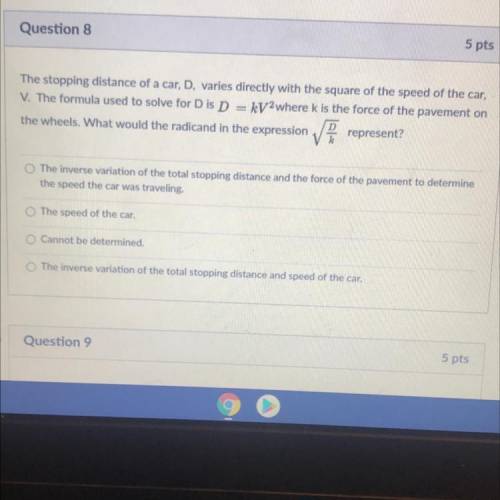
Mathematics, 04.11.2020 19:50 dondre54
The stopping distance of a car, D, varies directly with the square of the speed of the car,
V. The formula used to solve for Dis D = kV2 where k is the force of the pavement on
the wheels. What would the radicand in the expression represent?
The inverse variation of the total stopping distance and the force of the pavement to determine
the speed the car was traveling.
The speed of the car.
Cannot be determined.
The inverse variation of the total stopping distance and speed of the car.


Answers: 1
Another question on Mathematics

Mathematics, 21.06.2019 17:50
Graph y ≥ -x^2 - 1. click on the graph until the correct graph appears.
Answers: 1

Mathematics, 22.06.2019 01:30
Atriangle has side lengths of x, x+11, and 3x+5. what is the perimeter? question 1 options: 3x2+38x+55 3x3+38x2+55x 5x+16 4x+16
Answers: 2

Mathematics, 22.06.2019 02:00
Study published in the journal of personality and individual differences found that adults with adhd displayed more creative achievement than those who didn't have the disorder. "for the same reason that adhd might create problems, like distraction, it can also allow an openness to new ideas," says holly white, assistant professor of cognitive psychology. "not being completely focused on a task lets the mind make associations that might not have happened otherwise." white and priti shah at the university of michigan gave 60 college students – half of them with adhd – a series of tests measuring creativity across 10 domains. the adhd group scored higher across the board. the adhd group showed more of a preference for brainstorming and generating ideas than the non-adhd group, which preferred refining and clarifying ideas. the adhd status of the participants was established by asking whether the individual had ever been clinically diagnosed with adhd/add. the tests of creativity were pencil-and-paper tasks administered in a laboratory setting. each of the ten scales was comprised of multiple questions, the scores on which were summed (e.g., writing creativity: "how many words can you make from the letters in the word 'psychology' invention creativity: "write down as many uses for a paper clip that you can think of.") this procedure does allow for a participant to be scored as showing no creativity under these conditions. a) state the research question in plain language (i wonder if is related to (1 point) b) state the null hypothesis (1 point) c) state the research hypothesis (1 point) d) is the research hypothesis directional or non-directional (1 point) e) name the predictor / independent variable f) give the operational definition of the predictor / independent variable g) evaluate the construct validity of the predictor / independent variable. (face, procedure, method-match) h) name the outcome / dependent variable i) give the operational definition of the outcome / dependent variable. j) evaluate the construct validity of the outcome / dependent variable. (face, procedure, method-match)
Answers: 1

Mathematics, 22.06.2019 03:50
Which additional information, if true, would to prove that δlmp ≅ δnmp by hl? check all that apply.
Answers: 1
You know the right answer?
The stopping distance of a car, D, varies directly with the square of the speed of the car,
V. The...
Questions






















